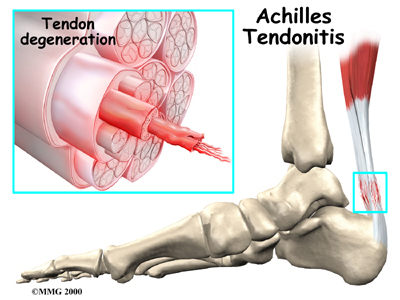What is Tendonitis?
Chronic, or long-term, tendon problems are common. Tendon problems are especially common in people who play certain types of sports. Tendon problems account for almost 30 percent of all running injuries and 40 percent of all tennis injuries.
Tendons connect muscle to bone. A tendon is made of material called collagen. Collagen is a key building block of the body. Collagen is considered a connective tissue because it forms tough strands that are like the strands of a nylon rope. Like the strands in a rope, the strands of collagen line up. The more strands, and the better they line up, the stronger they are. The tendon is wrapped in a thin, slippery covering called the tendon sheath. The tendon sheath allows the tendon to slide easily against the tissues around it.

Many parts of the tendon can be injured. Tendon problems can involve the area where the tendon attaches to the bone, the tissue that surrounds the tendon (the tendon sheath), or the main tissues of the tendon. Doctors use different terms to refer to injuries of different parts of the tendon.
Tendon injuries can show up anywhere in your body. Doctors see tendonitis most often in certain sites; Achilles Tendonitis, Rotator Cuff Tendonitis, De Quervain’s Disease and Trigger Finger and others.
For instance, in achilles tendonitis, as shown in the illustration, can involve a damage to the tendon sheath, the tissues of the tendon, and the attachment to the bone. Damaged Achilles tendons carry a higher risk of rupturing because of the weight they bear while standing and walking.
Why do I have this problem?
Doctors don’t know exactly what causes most tendon problems. They think that repetitive stress on the tendon is the most common cause. Too much stress on the tendons can be made worse by other factors. Lack of flexibility or weakness in your muscles can make tendonitis more likely. Shoes that don’t fit right, poor equipment, or incorrect technique can also increase your risk of tendon injury. Don’t underestimate the benefit of upgrading your equipment. The improved design of athletic shoes over the past few decades seems to have decreased tendon injuries. Aging seems to cause tendon damage in some cases. As we age, the tissues of the tendon can break down, or degenerate. Age-related tendon problems do not seem to cause inflammation. The tendon material itself is more affected in these conditions and some surgeon’s refer to this type of tendon problem as tendonosis.
Diagnosis
When you visit Health Bound Health Network, our physiotherapist will take a detailed medical history, including many questions about your activities, your job, and your symptoms. We will also physically examine the sore area. The probing and movement may cause pain, but it is important for us to know exactly where it hurts. Some patients may be referred to a doctor for further diagnosis. Once your diagnostic examination is complete, the physiotherapists at Health Bound Health Network have treatment options that will help speed your recovery, so that you can more quickly return to your active lifestyle.
Our Treatment
Tendon problems can be difficult to treat effectively. They can last for many months to several years, even with treatment. Although the amount of time needed for recovery varies, you should expect your treatment to take from six to nine months. Even if treatment is effective, your pain may come back. The exact treatment your physiotherapist at Health Bound recommends depends on which tendon is affected. If there are signs of true inflammation, our physiotherapist will probably suggest that you use nonsteroidal anti-inflammatory drugs (NSAIDs), such as aspirin and ibuprofen, to help control the inflammation and pain. NSAIDs are usually used for a short time with tendon problems. We may also suggest ice or heat treatments.
You will need to rest and give your body time to heal. If playing tennis injured your tendon, stop playing tennis until it is completely healed. You should only take part in activities that don’t strain the injured tendon.
When you begin your rehabilitation program at health Bound, our physiotherapist will teach you stretches and exercises to help your tendon heal and regain its strength. We can also assess your work site and athletic equipment and recommend changes to reduce the strain on your tendon. Depending on your type of injury, we may ask you to try such special equipment as arch supports, heel lifts, and splints.
Most people with chronic tendon problems can find ways to relieve the pain and take part in their normal activities, even if the problem doesn’t completely go away. In a few cases, patients can’t find ways to manage the pain even after six months. For these few patients, surgery may be necessary. Surgery may be successful in relieving the pain of chronic tendonitis.
If you or someone you know have tendinitis and would like to book an appointment with one of our therapists please do not hesitate to contact us.


